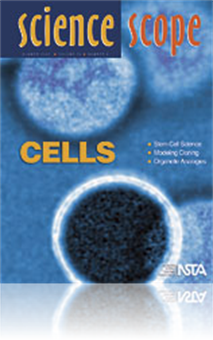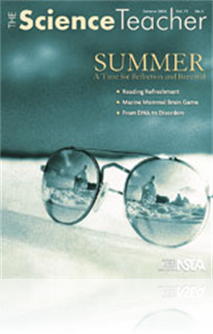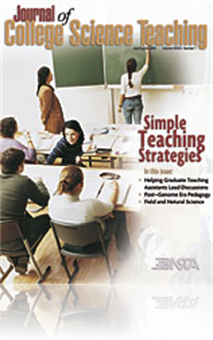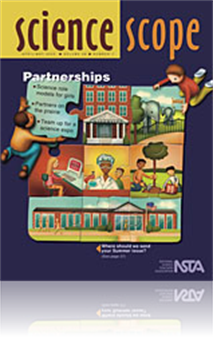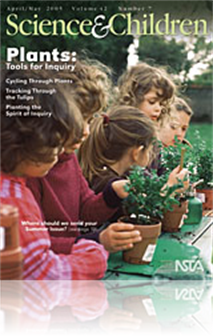All Resources
Journal Article
Guided by an Inventor’s Log and the process of scientific inquiry, students problem solve, think creatively, and budget their time and resources to brainstorm and build an invention. Students present their inventions to the class and to the communi...
Journal Article
Dolphins, manatees, and sea lions are all aquatic mammals but are not closely related taxonomically. All three species are marine mammals, meaning they spend part or all of their lives in the sea and contiguous bodies of water. In this unique standar...
Journal Article
Scope on Safety: More ergo, less aargh!
Is your job a pain in the neck, wrist, or back? If so, ergonomics may provide you with some relief. Ergonomics is the science of adapting workstations, tools, equipment, and job practices to be compatible with the individual worker and thus reduce th...
Journal Article
Career of the Month: An Interview with Aquaculture Veterinarian Roy P.E. Yanong
Did you know that fish have doctors too? Although this may sound "fishy", it's true! In this issue's Career of the Month column, you'll meet fish doctor Roy P.E. Yanong, an Aquaculture Veterinarian, and discover this intriguing career in the process....
Journal Article
Field and Natural Science: A Blend of Content and Pedagogy for Preservice Teachers
This article describes a field biology course specifically designed for students planning to teach in the elementary or middle-level grades. The fundamental goal of the course is to improve students’ science literacy and enhance their ability to ap...
Journal Article
Lessons from The Little Prince
This article discusses the ways the classic children’s book touches on issues teachers face and suggests analogies between the encounters of the Little Prince and the challenges of making science meaningful for our students....
Journal Article
Science Sampler: Analogy of the cell project
In this inquiry-based science project, students compare the makeup of a cell to an everyday working unit or system and create a three-dimensional object that represents their analogy. In addition, students select five specific organelles to include i...
Journal Article
AIDS and other Human Diseases: Teaching Science in the Context of Culture
A course on AIDS presents many interdisciplinary opportunities as well as interactive pedagogies. In an AIDS course at Whittier College, students learn about the biological basis and epidemiology of the disease, tackle current policy issues in the Un...
Journal Article
Research and Teaching: Using Action Research to Improve Teaching and Student Learning in College
An action research approach was used to examine revisions made to the design and delivery of a freshman zoology laboratory section. Because action research involves iterative cycles of planning, acting, observing, and reflecting, we raised and invest...
Journal Article
Editorial: A Community Challenge -- Career Support for Postdocs
Those long in the tooth will remember when a typical postdoc appointment was usually a relatively short hiatus between the completion of a dissertation and a more permanent position. Once finished polishing the work, got a publication or two out of ...
Journal Article
Teaching with Java Applets: Using Online Demonstrations in Large Classes of Nonscience Majors
Instructors can use interactive Java applets to present science in a concrete and meaningful manner to nonscience majors. This article shows how applets can take the place of laboratory work and gives examples and benefits of using applets....
Journal Article
Teaching Critical-Thinking Skills Using Course Content Material: A Reversal of Roles
The strategy of getting students to understand science content using critical thinking has been widely used by instructors for decades. The methodology presented here was used to teach and improve critical-thinking skills in an atmosphere that focuse...
Journal Article
Genes and Race in the Classroom: Science in a Social Context
This article describes a course for nonscience majors that uses the issue of race in humans to stimulate interest in genetics and other sciences. Student outcomes, including valuing and understanding science, plus an ability to discuss the sensitive ...
Journal Article
The Living Earth: Inviting Students into the World of Scientific Research through Seismology
In an introductory geoscience course, various elements of seismology were combined -- such as seismographs, seismograms, simulation of earthquake processes, and data analysis -- with open-ended problem solving to support preservice elementary teacher...
Journal Article
FIRST: A Model for Developing New Science Faculty
Developing education skills in future college faculty is challenging. At the postdoctoral level, Fellowships in Research and Science Teaching (FIRST) fellows effectively integrate research with mentored undergraduate teaching experiences and foster i...
Journal Article
Modeling the Research Process: Alternative Approaches to Teaching Undergraduates
An Introduction to Research course was modified to better teach the process of scientific inquiry to students who were not engaged in research projects. Students completed several tasks involved in research projects, including making presentations in...
Journal Article
Favorite Demonstration: A Fruity Biochemistry Demonstration
Inquiry, high-order thinking, reasoning skills, and critical thinking are buzzwords for the outcomes for which college science instructors strive. They can all be succinctly summarized as "get students thinking about what they are learning." Classr...
Journal Article
Society for College Science Teachers: Grade Inflation -- Is Ranking Students the Answer?
In recent years, several solutions have been proposed at various institutions nationwide to curb the phenomena of "grade inflation". Solutions include limiting the number of A's awarded, converting to a +/- system, publishing the class GPA next to e...
Journal Article
The Case Study: The Pima Experience -- Three Easy Pieces
The Academic Director of a University Honors Program in Buffalo, NY finds himself at Pima Community College, one of the nation's premier minority/majority systems. While working on an NSF grant, it was proposed that his group travel the country, dis...
Journal Article
Spice up your science curriculum by partnering with a local university to bring talent and resources into your classroom-- it's not as daunting as you think! This article raises awareness of GK-12 programs by sharing experiences from SPICE (Science P...
Journal Article
Editor's Note (April/May 2005)
No matter how the seasons come and go in your part of the country, there is science to be explored. In this section the editor discusses moving beyond the beauty of spring and presents a new way to think about plants--as tools for inquiry....
Journal Article
Tech Trek: How reliable is the temperature forecast?
The internet has become as commonplace as a daily newspaper, and is a primary source of news for middle school students. Access to up-to-the minute weather forecasts is something most students take for granted. However, like most of us, middle school...
Journal Article
Science 101: What causes tsunamis?
The word "tsunami" brings to mind one towering wave but actually refers to a series of waves, most often caused by an undersea earthquake. This article debunks some of the myths about tsunamis and gives a historic and scientific view of this natural...
Journal Article
Tried and true: It's all done with mirrors
Reflect the magic of science using the following activities to spur an interest in the study of light and its associated properties with the use of mirrors--these activities are designed to startle the senses! With a little time, students usually ca...
Journal Article
Ask the Experts -- April/May 2005
In this month's Ask the Experts column, the following questions are addressed: "Why does metal feel cold? And why are metals shiny?" and "Why does the United States use different electrical standards compared to Europe (120 V at 60 Hz versus 240 V at...
Journal Article
Learn about the partnership formed between students from Purdue University’s, "Engineering Projects In Community Service" (EPICS) and students at Happy Hollow School in Indiana, and how the engineering projects that were undertaken captured studen...
Journal Article
Commentary: The Value of Science Research Projects
In this month's Commentary, the value of science research projects is emphasized. The authors of this article have found that conservatively such projects could potentially have a positive impact on curricular requirements, regardless of the percepti...



